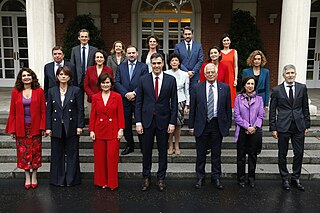Related Research Articles

A tithe is a one-tenth part of something, paid as a contribution to a religious organization or compulsory tax to government. Today, tithes are normally voluntary and paid in cash or cheques or more recently via online giving, whereas historically tithes were required and paid in kind, such as agricultural produce. After the separation of church and state, church tax linked to the tax system are instead used in many countries to support their national church. Donations to the church beyond what is owed in the tithe, or by those attending a congregation who are not members or adherents, are known as offerings, and often are designated for specific purposes such as a building program, debt retirement, or mission work.
The alcabala or alcavala was a sales tax of up to fourteen percent, the most important royal tax imposed by Spain in the early modern period. It applied in Spain and the Spanish dominions. The Duke of Alba imposed a five percent alcabala in the Netherlands, where it played an important role in the Dutch Revolt. Unlike most taxes in Spain at the time, no social classes were entirely exempt, although from 1491 clergy were exempt on trade that was "not for gain." Certain towns were also, at times, given exemptions.
Travelgenio was a Spanish online travel agency created in 2010 by the Argentinean entrepreneur Mariano Pelizzari. The company also published a survey of trends and customer satisfaction in the air travel industry.
Julia Castelló Farré is a Paralympic swimmer from Spain.

The first government of Pedro Sánchez was formed on 7 June 2018, following the latter's election as Prime Minister of Spain by the Congress of Deputies on 1 June and his swearing-in on 2 June, as a result of the success of a motion of no confidence against Mariano Rajoy. It succeeded the second Rajoy government and was the Government of Spain from 7 June 2018 to 13 January 2020, a total of 585 days, or 1 year, 7 months and 6 days.
The 8th annual Billboard Latin Music Awards which honor the most popular albums, songs, and performers in Latin music took place in Miami.

The first government of Isabel Díaz Ayuso was formed on 20 August 2019, following the latter's election as President of the Community of Madrid by the Assembly of Madrid on 14 August and her swearing-in on 19 August, as a result of the People's Party (PP) and Citizens (Cs) being able to muster a majority of seats in the Assembly with external support from Vox following the 2019 Madrilenian regional election. It succeeded the Garrido government and was the Government of the Community of Madrid from 20 August 2019 to 21 June 2021, a total of 671 days, or 1 year, 10 months and 1 day.

The first government of José Luis Rodríguez Zapatero was formed on 18 April 2004, following the latter's election as Prime Minister of Spain by the Congress of Deputies on 16 April and his swearing-in on 17 April, as a result of the Spanish Socialist Workers' Party (PSOE) emerging as the largest parliamentary force at the 2004 Spanish general election. It succeeded the second Aznar government and was the Government of Spain from 18 April 2004 to 14 April 2008, a total of 1,457 days, or 3 years, 11 months and 27 days.

The second government of José Luis Rodríguez Zapatero was formed on 14 April 2008, following the latter's election as Prime Minister of Spain by the Congress of Deputies on 11 April and his swearing-in on 12 April, as a result of the Spanish Socialist Workers' Party (PSOE) emerging as the largest parliamentary force at the 2008 Spanish general election. It succeeded the first Zapatero government and was the Government of Spain from 14 April 2008 to 22 December 2011, a total of 1,347 days, or 3 years, 8 months and 8 days.

The first government of Mariano Rajoy was formed on 22 December 2011, following the latter's election as Prime Minister of Spain by the Congress of Deputies on 20 December and his swearing-in on 21 December, as a result of the People's Party (PP) emerging as the largest parliamentary force at the 2011 Spanish general election. It succeeded the second Zapatero government and was the Government of Spain from 22 December 2011 to 4 November 2016, a total of 1,779 days, or 4 years, 10 months and 13 days.

The second government of Mariano Rajoy was formed on 4 November 2016, following the latter's election as Prime Minister of Spain by the Congress of Deputies on 29 October and his swearing-in on 31 October, as a result of the People's Party (PP) emerging as the largest parliamentary force at the 2016 Spanish general election. It succeeded the first Rajoy government and was the Government of Spain from 4 November 2016 to 7 June 2018, a total of 580 days, or 1 year, 7 months and 3 days.

The first government of José María Aznar was formed on 6 May 1996, following the latter's election as Prime Minister of Spain by the Congress of Deputies on 4 May and his swearing-in on 5 May, as a result of the People's Party (PP) emerging as the largest parliamentary force at the 1996 Spanish general election. It succeeded the fourth González government and was the Government of Spain from 6 May 1996 to 28 April 2000, a total of 1,453 days, or 3 years, 11 months and 22 days.

The second government of José María Aznar was formed on 28 April 2000, following the latter's election as Prime Minister of Spain by the Congress of Deputies on 26 April and his swearing-in on 27 April, as a result of the People's Party (PP) emerging as the largest parliamentary force at the 2000 Spanish general election. It succeeded the first Aznar government and was the Government of Spain from 28 April 2000 to 18 April 2004, a total of 1,451 days, or 3 years, 11 months and 21 days.

The third government of Felipe González was formed on 7 December 1989, following the latter's election as Prime Minister of Spain by the Congress of Deputies on 5 December and his swearing-in on 6 December, as a result of the Spanish Socialist Workers' Party (PSOE) emerging as the largest parliamentary force at the 1989 Spanish general election. It succeeded the second González government and was the Government of Spain from 7 December 1989 to 14 July 1993, a total of 1,315 days, or 3 years, 7 months and 7 days.

The fourth government of Felipe González was formed on 14 July 1993, following the latter's election as Prime Minister of Spain by the Congress of Deputies on 9 July and his swearing-in on 13 July, as a result of the Spanish Socialist Workers' Party (PSOE) emerging as the largest parliamentary force at the 1993 Spanish general election. It succeeded the third González government and was the Government of Spain from 14 July 1993 to 6 May 1996, a total of 1,027 days, or 2 years, 9 months and 22 days.

The second government of Pedro Sánchez was formed on 13 January 2020, following the latter's election as Prime Minister of Spain by the Congress of Deputies on 7 January and his swearing-in on 8 January, as a result of the Spanish Socialist Workers' Party (PSOE) emerging as the largest parliamentary force at the November 2019 general election. It succeeded the first Sánchez government and is the incumbent Government of Spain since 13 January 2020, a total of 1,317 days, or 3 years, 7 months and 9 days.

The fifth government of Francisco Franco was formed on 25 February 1957. It succeeded the fourth Franco government and was the Government of Spain from 25 February 1957 to 11 July 1962, a total of 1,962 days, or 5 years, 4 months and 16 days.

Alejandro "Àlex" Casademunt González was a Spanish pop singer, actor, and TV presenter. He entered the music industry after finishing in tenth place in the musical contest Operación Triunfo 2001.

The second government of Isabel Díaz Ayuso was formed on 21 June 2021, following the latter's reelection as President of the Community of Madrid by the Assembly of Madrid on 18 June and her swearing-in on the next day, as a result of the People's Party (PP) emerging as the largest parliamentary force at the 2021 Madrilenian regional election. It succeeded the first Ayuso government and has been the incumbent Government of the Community of Madrid since 21 June 2021, a total of 792 days, or 2 years, 2 months and 1 day.
References
- Schwaller, John Frederick (February 22, 2011), The History of the Catholic Church in Latin America: From Conquest to Revolution and Beyond, NYU Press, ISBN 978-0-8147-4003-3